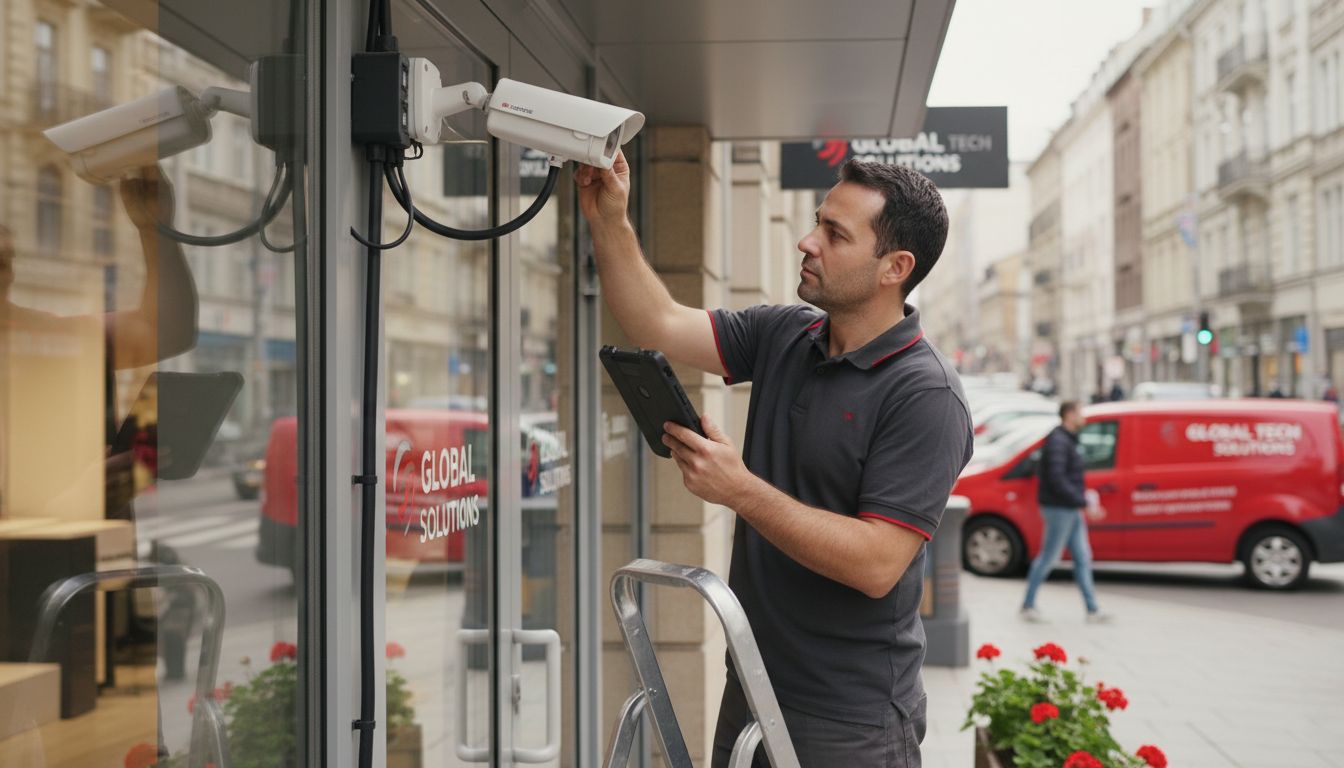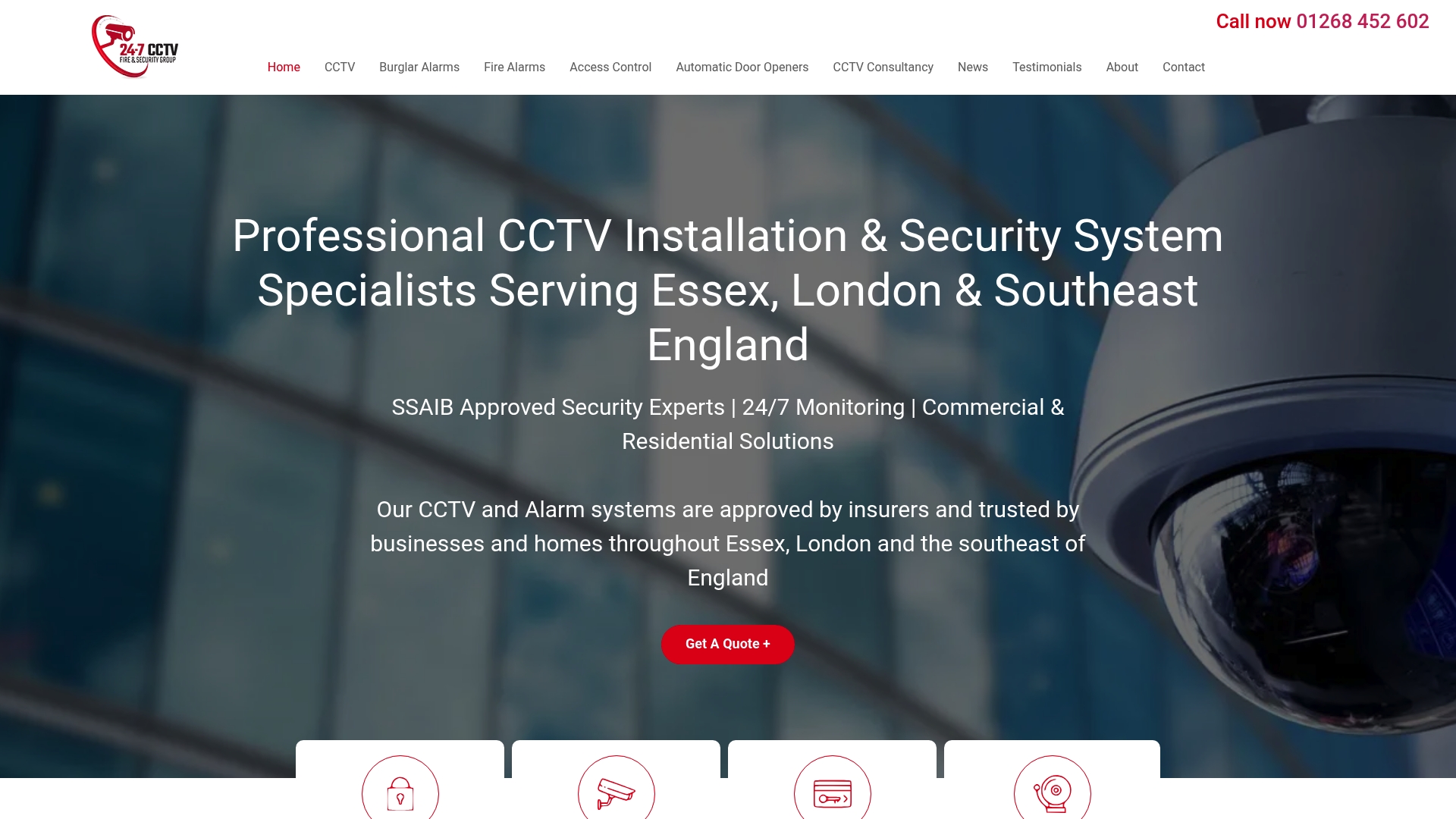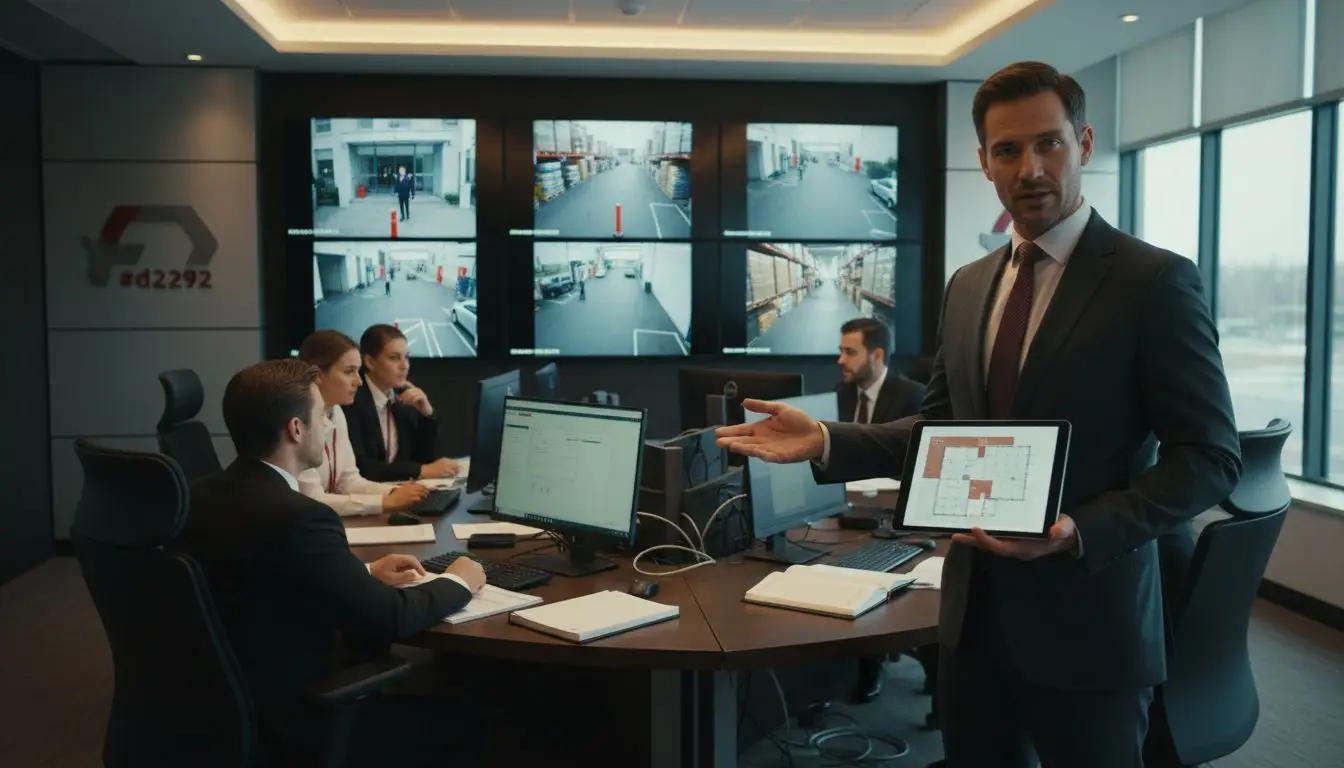Did you know that nearly 60 percent of UK businesses have experienced property crime in the last year? Protecting your premises goes far beyond a simple lock and key. A well-planned CCTV system helps deter theft and supports legal compliance, yet many overlook the details that make surveillance truly effective. From mapping out vulnerable spots to selecting the right camera type, each decision shapes the security of your business.
Table of Contents
- Step 1: Assess Site Security Needs And Plan CCTV Layout
- Step 2: Select Suitable CCTV Equipment And Storage Options
- Step 3: Install Cameras And Run Cables Securely
- Step 4: Connect DVR/NVR And Configure System Settings
- Step 5: Test Camera Views And Verify System Operation
Quick Summary
| Key Point | Explanation |
|---|---|
| 1. Assess Site Security Needs First | Conduct a thorough walkthrough to identify critical areas that require CCTV surveillance for effective security planning. |
| 2. Choose Appropriate Camera Types | Match camera types to specific locations and requirements, considering features like wide angles, weatherproofing, and resolution. |
| 3. Ensure Proper Camera Installation | Install cameras at optimal heights and ensure they cover key areas while considering cable management for durability. |
| 4. Configure DVR/NVR Settings Correctly | Set up your recording device with strong passwords and individualized recording settings for storage efficiency and security. |
| 5. Conduct Comprehensive System Testing | Verify camera functionality and recording capabilities while ensuring all settings are effective for complete coverage. |
Step 1: Assess Site Security Needs and Plan CCTV Layout
Before installing business CCTV, you need a strategic approach that identifies your specific security requirements and designs an optimal camera layout. According to the Where to Put & Install CCTV Cameras guide, understanding your site topology is crucial for effective surveillance.
Start by conducting a comprehensive walkthrough of your premises. Identify key areas that require monitoring such as entry points, cash handling zones, storage rooms, and high traffic corridors. Consider both interior and exterior spaces to create a complete security map. Pay special attention to vulnerable spots like loading docks, parking areas, and perimeter boundaries.
Document potential blind spots and assess lighting conditions which significantly impact camera performance. Nighttime visibility requires different camera specifications compared to well-lit daytime environments. Measure physical dimensions and note architectural features that might obstruct camera views.
Pro Tip: Always consider privacy regulations. According to the Information Commissioner’s Office, you must evaluate and mitigate potential privacy risks before installation.
Prioritise critical zones based on their security significance. Entrances typically need wider angle cameras, while specific asset areas might require high resolution zoom capabilities. Consider camera types like dome cameras for discreet monitoring or bullet cameras for long distance tracking.
Here’s a summary of camera types and their recommended uses:
| Camera Type | Typical Location | Key Features |
|---|---|---|
| Dome Camera | Indoors Reception | Discreet Wide angle view |
| Bullet Camera | Outdoors Perimeter | Weatherproof Long range |
| PTZ Camera | Large open areas | Pan/Tilt/Zoom Remote control |
| Turret Camera | Entrances Car parks | Vandal resistant Good visibility |
| Fisheye Camera | Lobbies Retail floors | 360° view Minimal blind spots |
Your next step will involve selecting appropriate camera specifications and determining precise mounting locations to maximise coverage while respecting legal privacy guidelines.
Step 2: Select Suitable CCTV Equipment and Storage Options
Choosing the right CCTV equipment is critical for creating an effective security system. According to the 6 Key CCTV System Features guide, selecting appropriate technology can dramatically enhance your business security.
Start by evaluating camera types based on your specific environment. Indoor spaces might require dome cameras for discreet monitoring, while external areas need weatherproof bullet cameras with robust night vision capabilities. Resolution matters significantly consider 4K cameras for high detail areas like cash registers or entry points where precise image capture is essential.
Storage solutions are equally important. Digital video recorders or network video recorders provide different benefits depending on your infrastructure. Cloud storage offers remote access and redundancy while local storage provides immediate control. Determine your retention requirements some businesses need 30 days of footage others might require longer periods.
Pro Tip: According to the Information Commissioner’s Office data protection guidelines ensure your storage method complies with privacy regulations and securely protects recorded information.
Consider additional features like motion detection smart alerts and remote viewing capabilities. Modern systems integrate artificial intelligence to distinguish between routine movements and potential security threats. Look for systems with flexible bandwidth usage and straightforward data management interfaces.
Your next phase will involve professional installation to ensure optimal camera positioning and seamless system integration.
Step 3: Install Cameras and Run Cables Securely
Securing your CCTV system requires meticulous camera placement and careful cable management. The CCTV Monitoring Setup Guide emphasises the importance of strategic installation to maximise security coverage.
Begin by mounting cameras at optimal heights typically between 8 to 10 feet above ground level. This positioning provides wide coverage while preventing easy tampering. Choose mounting surfaces that offer stability such as solid walls or robust ceiling structures. Ensure camera angles cover key areas without obstructions like signage or architectural features that might block critical viewpoints.
Cable routing demands careful planning to prevent potential damage and signal interference. Use conduit or cable trunking to protect wiring from environmental factors and potential physical damage.
 Keep cables away from electrical lines to minimise electromagnetic interference which can degrade video quality. Consider using cable management solutions that blend with your interior design for a professional appearance.
Keep cables away from electrical lines to minimise electromagnetic interference which can degrade video quality. Consider using cable management solutions that blend with your interior design for a professional appearance.
Pro Tip: According to the National Security Inspectorate installation guidelines ensure all cable connections are properly insulated and protected against environmental conditions.
Prioritise cable length and quality. Shorter cable runs reduce signal degradation while high grade CAT6 or fibre optic cables provide superior data transmission. For wireless systems carefully consider signal strength and potential interference from walls or electronic equipment.
Your next stage will involve configuring system settings and testing camera functionality to ensure comprehensive security coverage.
Step 4: Connect DVR/NVR and Configure System Settings
Configuring your digital video recorder or network video recorder is crucial for establishing a robust security system. Learn how to set up your system effectively with our guide on changing Hikvision NVR settings, which provides insights into precise configuration techniques.
Start by connecting your DVR or NVR to your network using an ethernet cable or wireless connection. Ensure a stable internet connection for remote monitoring capabilities. Power up the device and access the system interface through the provided monitor or remote software. Create a strong administrative password that combines uppercase and lowercase letters, numbers, and special characters to prevent unauthorized access.
Configure your recording settings based on your specific security requirements. Adjust resolution, frame rates, and storage allocation to balance video quality and storage efficiency. Set up motion detection zones to reduce unnecessary recording and conserve storage space. Schedule recording times during high traffic periods or after business hours for optimal surveillance coverage.
Pro Tip: According to the Surveillance Camera Commissioner guidelines ensure your system complies with data protection regulations by implementing appropriate privacy and access controls.
Set up remote viewing capabilities through mobile applications or web interfaces. This allows you to monitor your premises from anywhere using smartphones or computers. Configure email or push notifications for immediate alerts when motion is detected or unusual activities occur.
Your final step will involve thorough system testing to verify all cameras and settings function correctly.
Step 5: Test Camera Views and Verify System Operation
Comprehensive testing is critical to ensuring your CCTV system performs exactly as intended. Follow our CCTV camera maintenance guide to understand the nuanced approach to system verification and ongoing performance monitoring.
Begin by checking each camera individually through the monitoring interface. Walk through your mapped surveillance zones and confirm every camera captures clear images with the correct field of view. Test camera movement for pan tilt zoom models ensuring smooth and precise positioning. Verify night vision capabilities by simulating low light conditions or conducting tests during evening hours.
Verify recording functionality by triggering motion detection and confirming footage saves correctly. Check storage capacity and ensure the system overwrites older recordings when space becomes limited. Test remote access capabilities by logging into the system using mobile and web interfaces from different locations to confirm seamless connectivity.
Pro Tip: According to the Surveillance Camera Commissioner testing standards verify that all camera views provide complete coverage without compromising individual privacy.
Conduct comprehensive bandwidth and performance tests. Ensure multiple camera streams can be viewed simultaneously without significant lag or quality degradation. Check email and push notification configurations to confirm you receive alerts for unexpected movements or system events.
Your final step will involve creating a maintenance schedule to regularly inspect and update your CCTV system.
Secure Your Business Quickly with Expert CCTV Installation
Planning your business CCTV system involves tackling key challenges like identifying vulnerable areas, selecting the right cameras, and ensuring legal compliance all while aiming for seamless coverage without blind spots. This can feel overwhelming when you want to protect your premises effectively and minimise risks.
That is where experienced security professionals come in with tailored solutions. At 247 CCTV, we understand the importance of strategic camera placement, high specification equipment, and secure system configuration. Whether you need weatherproof bullet cameras for outdoor areas or discreet dome cameras inside, we guide you through the entire process.

Don’t leave your business exposed. Take control now by visiting our installation services to schedule a consultation. Benefit from expert advice, fast deployment, and ongoing support that aligns with industry standards and privacy laws. Protect your assets and staff with a CCTV system designed specifically for your premises today.
Frequently Asked Questions
What are the first steps to take when planning a business CCTV installation?
Before installing CCTV, conduct a thorough assessment of your security needs. Walk through your premises, identifying key areas to monitor such as entrances and high traffic zones, and create a detailed security map.
How do I choose the right type of CCTV cameras for my business?
Select camera types based on your specific monitoring environment. For example, use dome cameras for indoor areas and bullet cameras for outdoor spaces, ensuring you prioritize resolution and night vision capabilities for essential locations.
What should I consider when determining the CCTV camera layout?
Consider key factors like blind spots and lighting conditions when planning your camera layout. Aim for optimal camera heights and angles, typically between 8 to 10 feet, to enhance coverage while minimizing potential obstructions.
How can I ensure my CCTV system complies with privacy regulations?
Evaluate privacy risks and implement measures to mitigate them before installation. This includes considering camera placement and ensuring recorded footage is secured to comply with legal requirements.
How do I test the functionality of my CCTV system after installation?
Verify the system by checking each camera view and confirming they capture clear images. Conduct tests for motion detection and remote access functionality, ensuring alerts are working properly within the setup.
What maintenance is necessary for keeping my CCTV system operational?
Create a regular maintenance schedule to inspect camera views, storage capacity, and system settings. Conduct thorough checks every few months to ensure cameras function correctly and footage is stored as needed.

